[ZX Spectrum, KW Software]

– Lieutenant Narwhal ! We need you to defend our foothold on Guadalcanal !
– Again ?
– Yes, but this time your scout planes will suck and your carriers wings will refuse to cooperate !
We return once again to the Pacific War with, er, Pacific War, probably the most ambitious ZX Spectrum wargame I have played so far. And once again, my official objective – the pretext if you will – is to prevent the Japanese from landing on Guadalcanal, while my real objective – the one that will give me victory points – is to sink the numerous Japanese carriers.
In this campaign, I have 2 Fleet Carriers (the USS Saratoga and the USS Enterprise) and one escort carrier (the USS Wasp), facing 2 Japanese Fleet Carriers (the Zuikaku and the Shōkaku) and 3 Escort Carriers (the Taiyō, the Ryūjō and the Jun’yō)
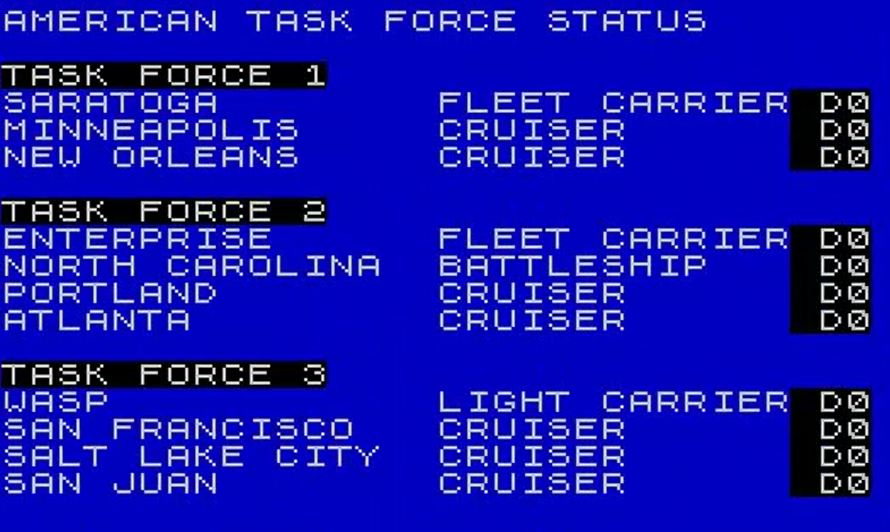

Each US Fleet Carrier carries 10 fighters, 10 bombers and 10 dive bombers, whereas the USS Wasp carries 8 of each. I don’t know whether the game takes into account the fact that Japanese carriers had fewer planes, but even if it does not I can count on Guadalcanal’s Henderson Field to balance things up ; its complement in planes is equivalent to the one of the USS Wasp.
Let’s start the battle. My task forces start in the bottom-right corner of the map, while the Japanese task forces start in random locations on the left and on the top of the map.
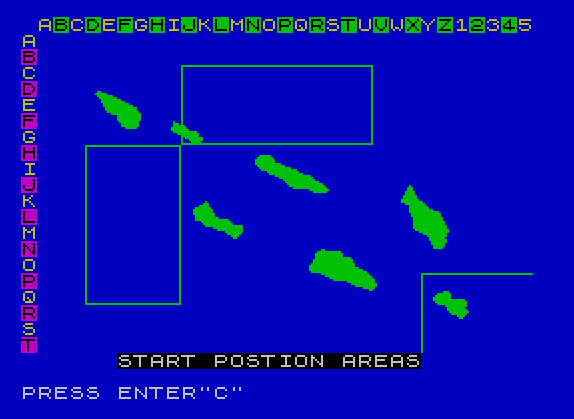
As soon as the game starts, I am forced to make some interesting – and difficult – decisions : how to search the seas :
- Each carrier (and Henderson Field) can only have 3 missions active at the same time, whether search or strike,
- I need to send planes to specific locations, instead of Guadalcanal Campaign’s generic “just search for the enemy and I’ll tell you if anything is in range”
- Once sent, planes cannot be called back until they complete their missions by reaching their target location,
- Planes only see the tiles they go through. The pilots never turn their heads left or right to check on the sides,
I therefore need to decide how many search missions to send and how far I want to send them.
- If I send all my search missions immediately, I won’t be able to send new ones for a long time,
- If I send the search missions far away, the planes will spend more time searching interesting areas; compared to just flying over a safe sea. Of course, in that case I lose one of my mission slots for longer.
After spending some time overthinking it, I decide to send only one “long-range” search mission by carrier and two short-range missions from Henderson field.
The planes and the ships are displayed on the same map, but ships move once – by one tile – at the beginning of each turn/day while planes move by 2 tiles by impulse, with 3 impulses by day.
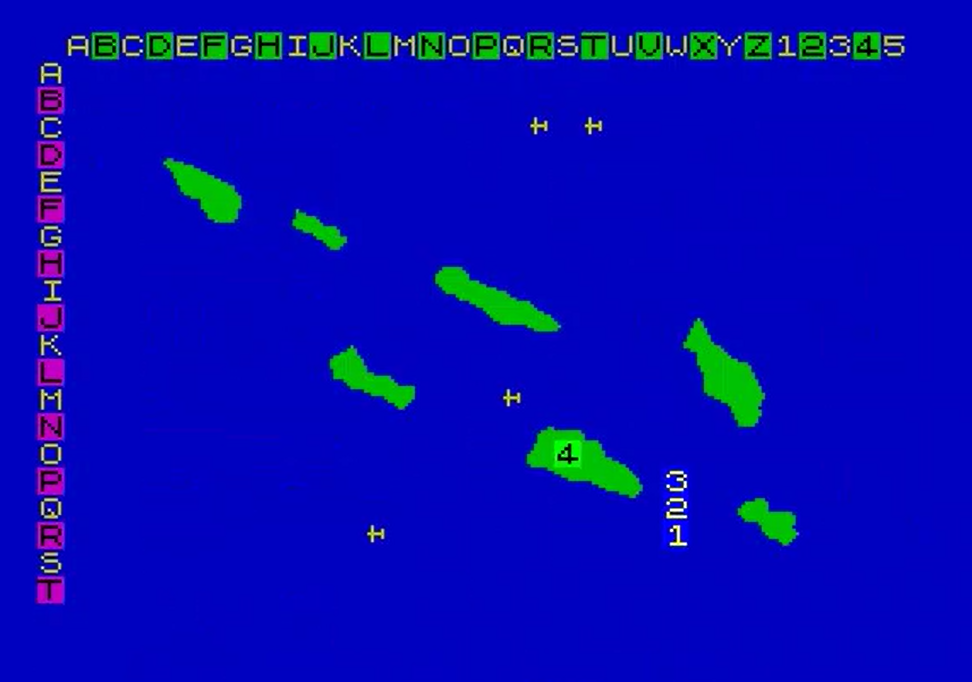
As time passes and I comb the seas, I don’t see any Japanese ships. Worried, I send the maximum possible scouts (2 by carriers, because I need to keep a mission slot for an airstrike) but I still don’t find anything !
Suddenly, at the end of day 3, planes appear out of nowhere and bomb Henderson Field ! My fighters in Combat Air Patrol (“CAP”, thankfully not counted as part of the 3 missions by carrier/airport) above Henderson Field intercept 11 enemy planes at the cost of 3 of my fighters. The rest of the enemy aircraft make it through and Henderson Field is hit twice. Just as worrying, I am informed that the USS Wasp is detected by an enemy aircraft.
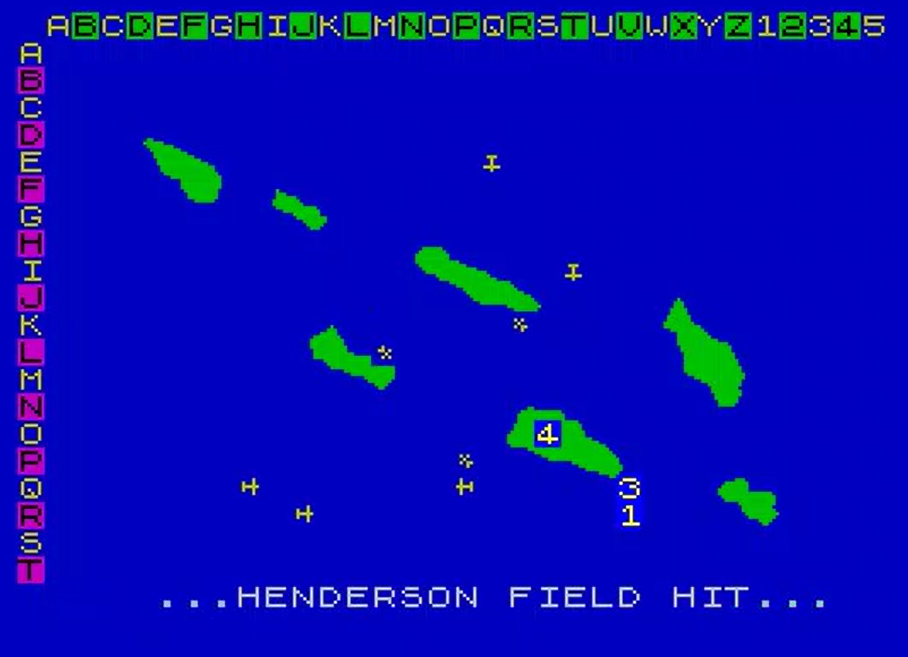
I assume that Japanese planes are now heading for the USS Wasp, so I order all my ships to turn East and escape. With some luck, the sea will be empty by the time the bombers arrive.
The 4th day of the campaign is better. First, the USS Wasp is not attacked by anyone so I probably evaded an enemy attack. Even better, some of my returning scouts detect the second Japanese Task Force (the Zuikaku) in the early afternoon. I immediately send toward the Zuikaku strike forces from Henderson Field, the USS Saratoga and the USS Enterprise, keeping one in reserve on the USS Wasp.
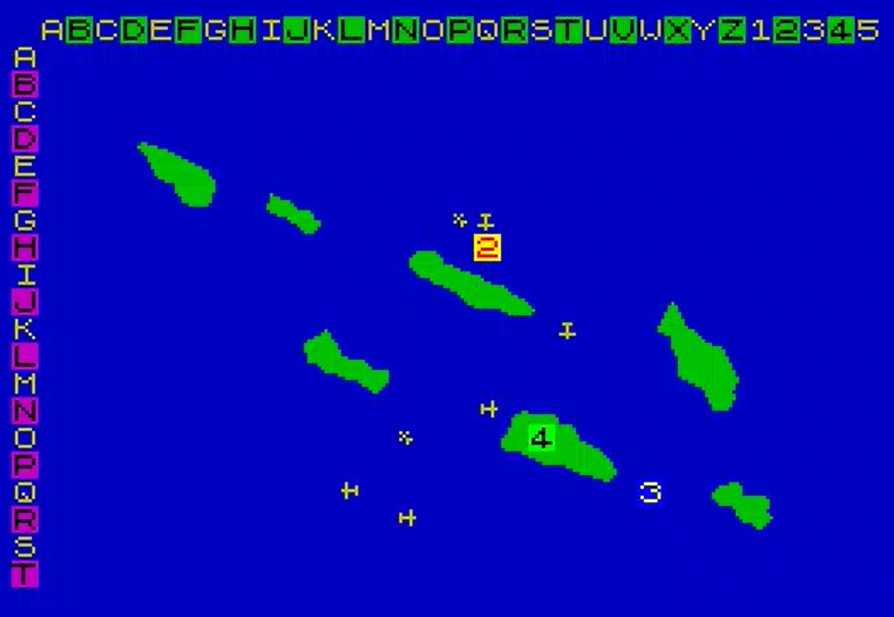
Night falls before my strike force can reach its target, and of course all fleets move during the night. I had actually expected this, and sent the strike forces on several possible “post-movement” locations. The planes from the USS Saratoga find the Zuikaku and badly damage her with minimal losses (2 planes !).

The strike force that left Henderson Field had been sent too much to the West and does not see the Zuikaku, but by luck they find another prey : the Japanese transport fleet. It has no fighter escort, and my planes have a field day :

After the planes from the USS Saratoga fail to find anything, my strike forces return. I immediately resend them as they land. The one from Henderson Field finds the Transport Fleet again, finishing off two cruisers and one transport.
Alas, there won’t be a third attack from Henderson Field, as it is disabled by another massive bomber attack. The pilots returning from their attack on the Transport Fleet have to choose between crash-landing on Guadacanal or ditching their planes into the sea. Tough decision, except for those who don’t know how to swim, for them the decision must have been straightforward.

Without the planes from Henderson Field, I lose 2 search missions starting from a central location, and the enemy fleets disappear from my view. This concludes the first part of the campaign. I feel like it is at best a draw so far.
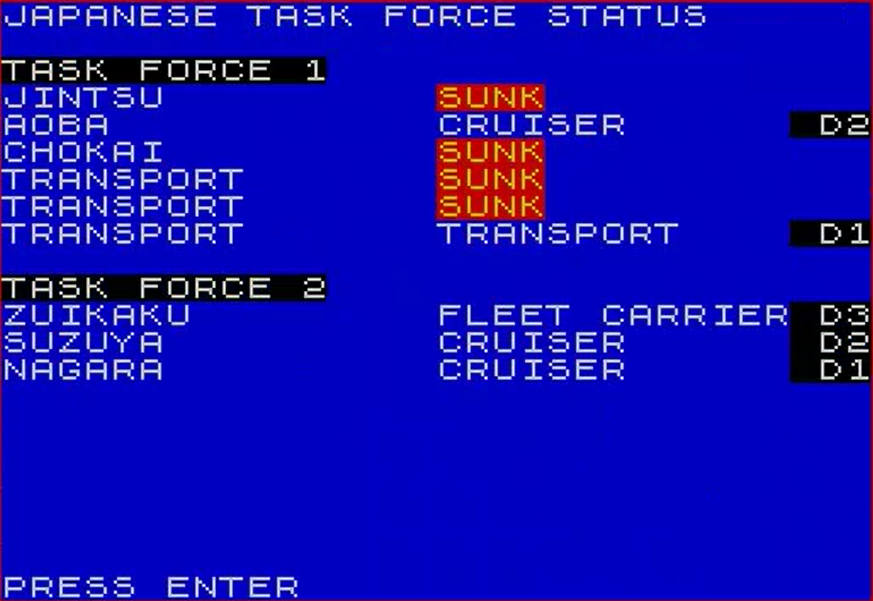
Of course, the Japanese are still there. Two days later, the USS Wasp is flown over by a Japanese plane and, soon thereafter, attacked. Fortunately, it seems the attack comes from an Escort Carrier as I intercept 10 planes (losing 3) and the survivors only manage to hit the USS Wasp once. The following day, I swap the position of the USS Wasp and the USS Enterprise, so the latter shields the former from planes coming from the North-West. This was wise, because I am soon hit by a second larger attack – I destroy 11 planes, lose most of my own fighters and receive two hits on the USS Enterprise. The location of the enemy is still unknown.
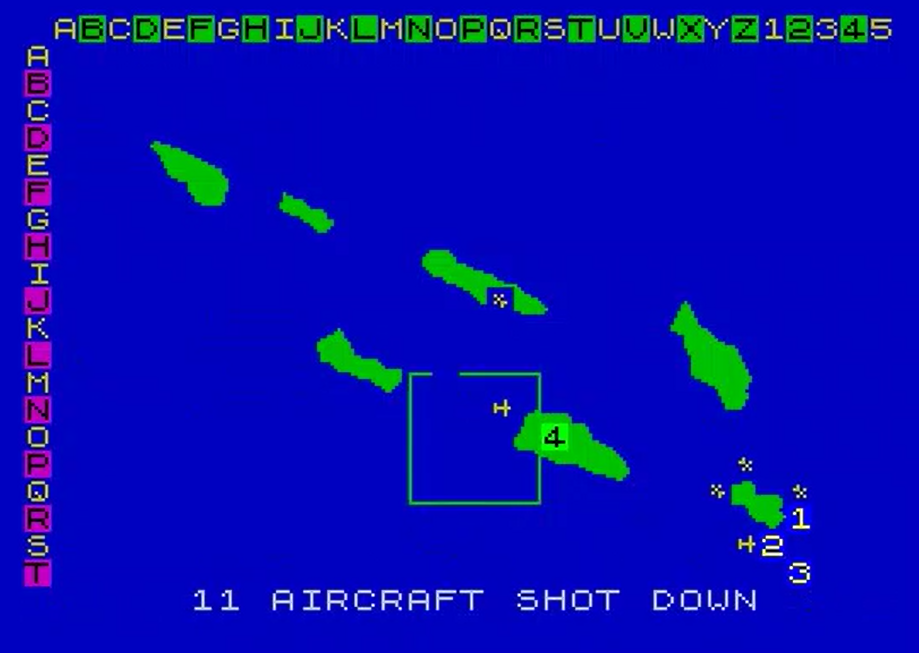
After hiding the USS Enterprise behind the USS Saratoga, I finally find the probable offender : it is the Shōkaku, covering a landing on Guadalcanal by the last transport ship !

I immediately send all my planes, except the fighters of the USS Saratoga kept in CAP. One of the strike forces reaches the Shōkaku. I don’t lose any of my planes, which presumably means the enemy Zeros are escorting bombers somewhere, and hit the Shōkaku 4 times. It is immediately sunk. Its escort is annihilated the same day when a second strike arrives
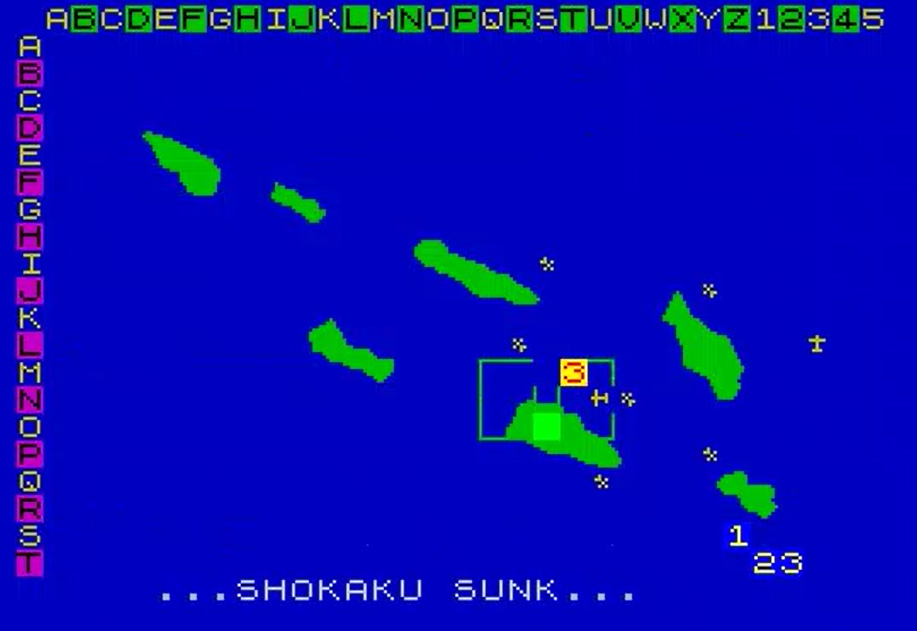
Well, that’s some good news. We are now at 2 Fleet Carriers and 1 Escort Carrier against 1 crippled Fleet Carrier and 3 Escort Carriers. Maybe I have a chance. What’s sure is that I have a massive advantage in points.

For the last phase of the campaign, I move my fleets West again. I don’t know at that point whether the transport can land troops on Guadalcanal every day or not, and I want to be able to sink the Japanese Transport Fleet as soon as possible after detection.
But I never detect the remaining Japanese transport ship. Instead, I find the Ryūjō at dangerously close range !
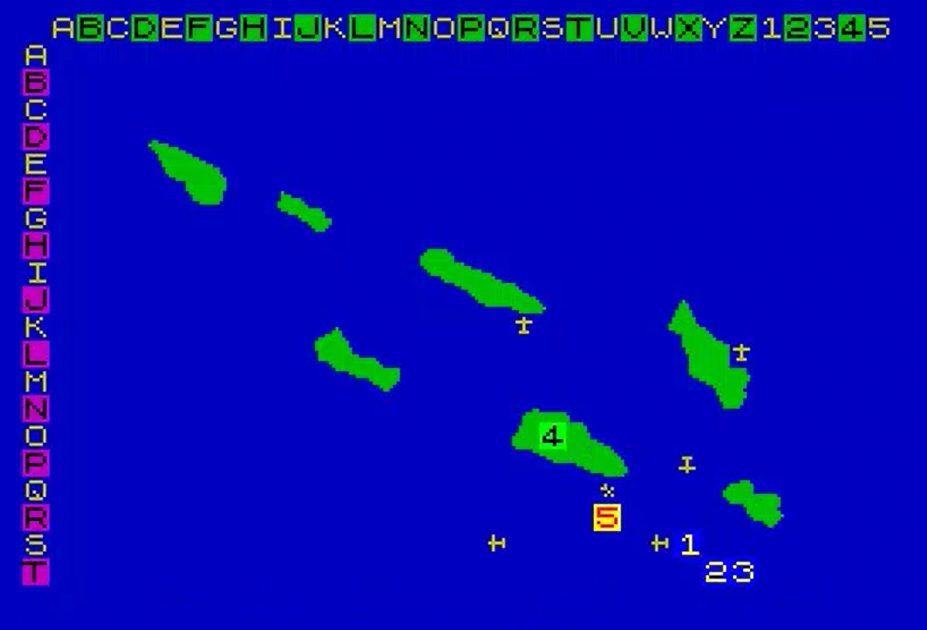
The USS Saratoga is immediately hit by 2 Japanese strike forces, one after the other. The first Japanese strike force receives catastrophic losses and does not damage the USS Saratoga, but the second one only loses 2 planes and hit the USS Saratoga 3 times ! When I check its status after the battle, I realize she is down to 1 fighter when it had 10 in the morning !
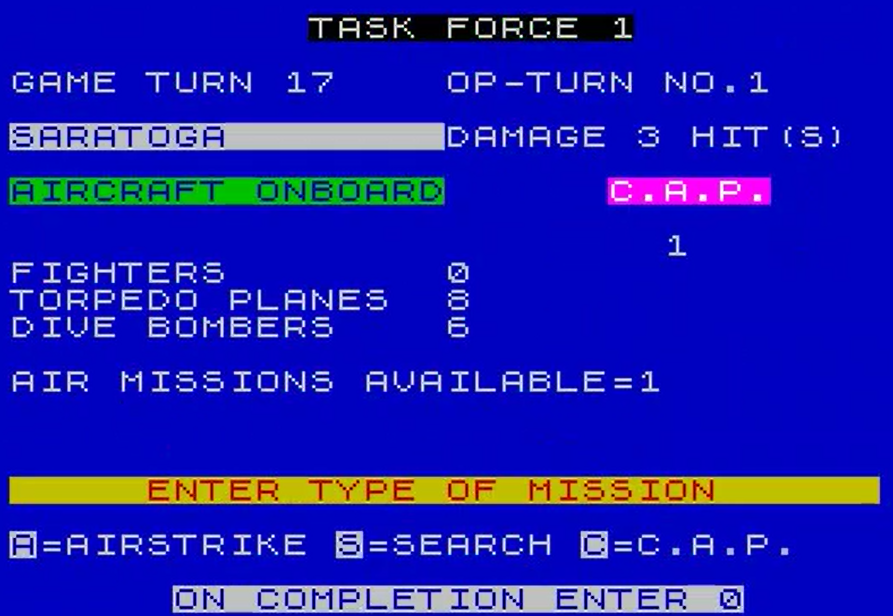
I swap the position of my ships again, moving the USS Wasp ahead, and send my strike forces after the Ryūjō. They don’t find her. Instead, my 3 strike groups find the Jun’yō (immediately sunk) and the Taiyō (damaged)

I pursue the Japanese as they escape, and I sink every single ship of the 4th and 6th Task Force, including the Yamato. Meanwhile, the Japanese manage to attack the USS Wasp twice, without causing any damage. Presumably, their remaining carriers are almost out of planes !
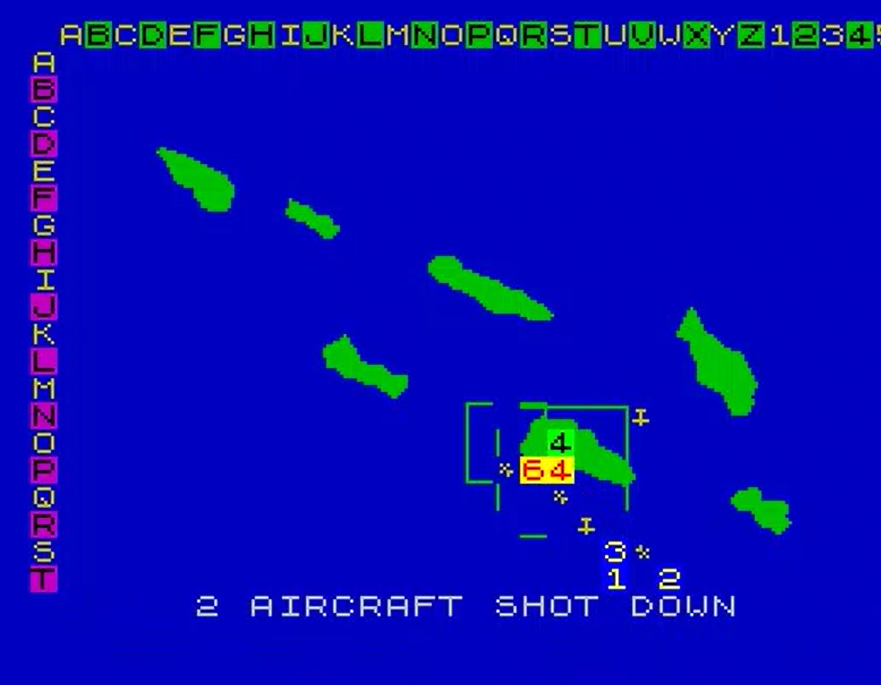
The night after destroying Task Forces 4 and 6, the game ends with a decisive American victory. The Ryūjō managed to escape me somehow.


For the second time (after Guadalcanal Campaign), the Zuikaku managed to survive my attacks. I wonder whether the computer retreats its damaged carriers in a corner of the map, or whether I was just unlucky.
Here is what’s left of both fleets :
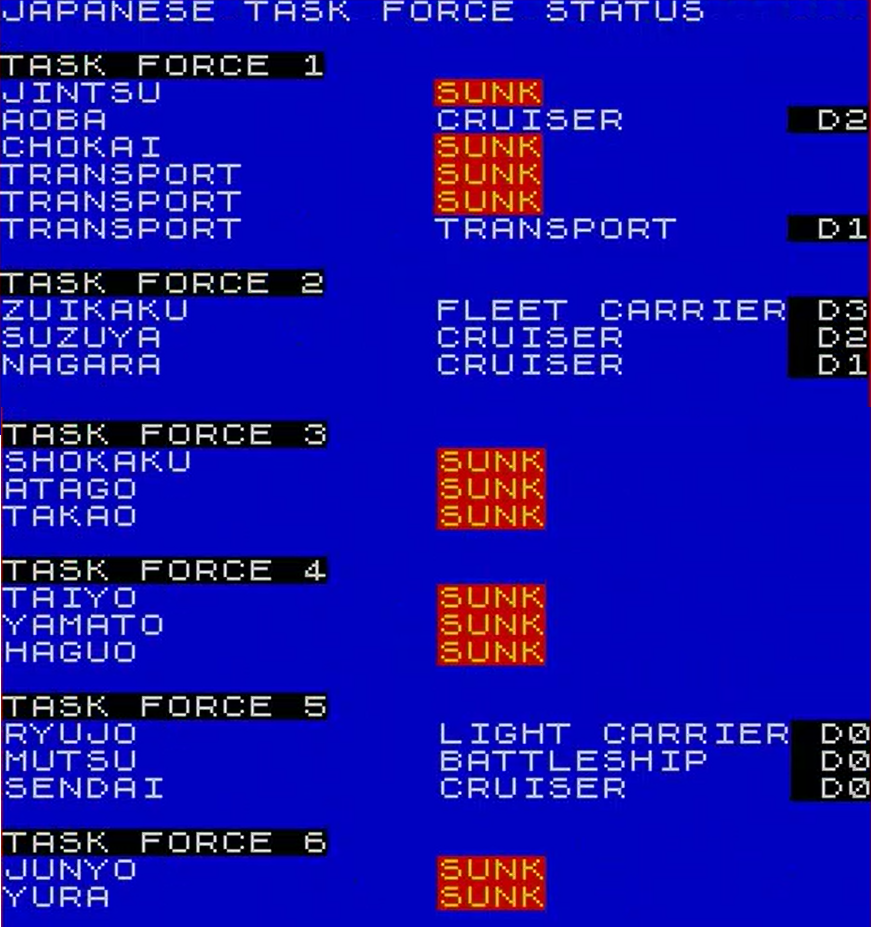

It was a surprisingly interesting game, and I had fun.
Rating & Reviews
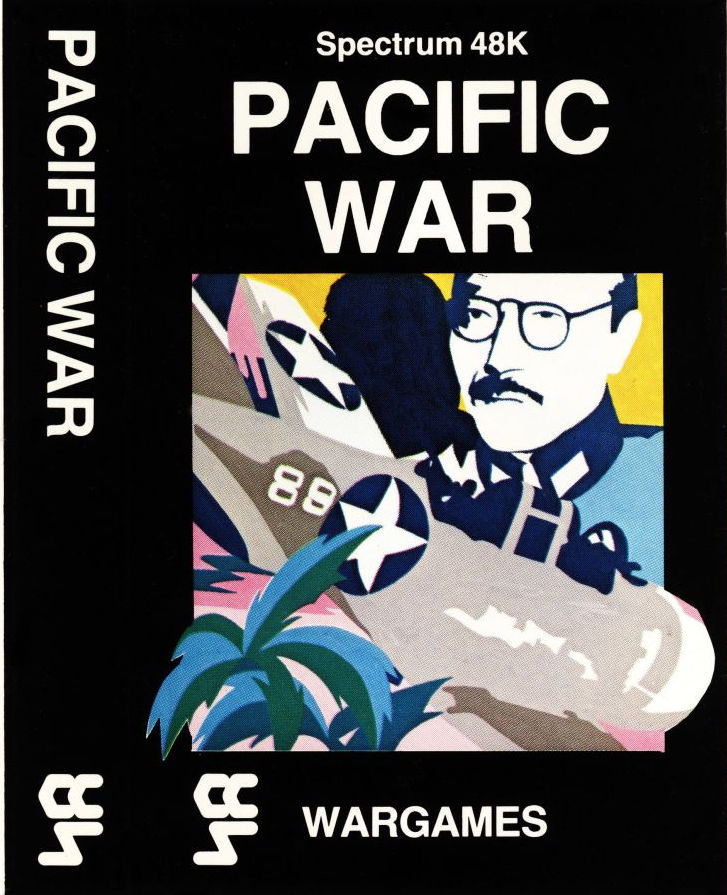
Pacific War, by Ken Wright, published KW Software (and later Cases Computer Simulations, UK)
First release : October 1983 on ZX Spectrum according to ads
Total time tested : Three hours
Average duration of a game : 1 hour and half
Complexity: Easy (1/5)
Would recommend to a modern player : No
Would recommend to a designer : Yes
Final Rating : Well-designed but obsolete
Ranking at the time of review : 17/101
Pacific War covers the air operations – and almost exclusively the air operations – of the Guadalcanal Campaign. While it has its issues, its focus on only one well-designed feature makes it a surprisingly interesting game that generates interesting decisions almost every turn.
Pacific War is a ZX Spectrum exclusive by Ken Wright, a wargame specialist on which frustratingly little is known. He gave no interview, was not featured in any article and even UK magazines talking about wargames ignore him – all I have is a paper trail of ads.
Wright’s first games seem to have been released in the second half of 1982, with a mysterious ad in Sinclair User that did not mention any specific game :
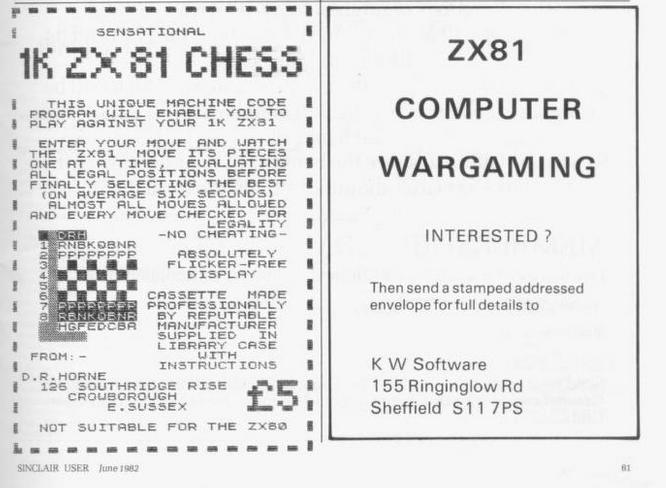
By early 1983, Wright must have realized that asking for a stamped envelope was maybe not the best use of ad space and listed the games he could provide for ZX81 :

Alas, Wright’s three ZX81 games are now lost, as are two of his 1983 ZX Spectrum games : Bankrupt and Midway. The only early Wright game that survived is Pacific War ; fortunately his later production that I will check in due time has been preserved. If his M.O. in later games is any indication, Midway is likely to be a reskin of Pacific War, with fewer islands and more Fleet Carriers.
Pacific War was later republished by CCS in conditions I know nothing about – CCS is a big name of British wargaming I will eventually cover, but not today. So moving on to the ratings :
A. Immersion
Poor. Pacific War focuses on air operations and ignores land operations, submarines, … Even for air operations Wright favoured gameplay over realism, so the end result is very pure gameplay lacking chrome and immersion. Still, you really wonder where are those freaking Japanese carriers and whether you are going to be hit next turn !
B. UI, Clarity of rules and outcome
Poor. The game lacks information that I feel you should know, like how many planes attacked you (or defended an enemy task force) and which ones you shot down, or even what’s the difference stat-wise between torpedo-bombers and regular bombers. The game also suffers from various minor irritating UI hiccups. Still, for a game about the Pacific War it is easy to play and even easier to understand.
While not a problem for today’s gamers using an emulator, the game is slow (I had to accelerate the emulator 2.5 times !) and has no save option. It took me more than 1 hour to finish a campaign, so it must have been quite the marathon in the 80s.
C. Systems
Quite good. That’s where the game shines by focusing on the fun part (the plane allocation) and either removing (submarines, ground combat) or streamlining the rest (no transfer of ships or planes, standard and limited number of planes by carrier, no fuel or plane range, etc). Giving only 3 missions by carriers make them count and force to take decision, and the player must constantly weight risk vs reward.
Still, I would have appreciated a bit more flexibility on the missions (eg “patrol an area” or at least a waypoint system rather than go to a specific point and return), an indication on where the enemy planes come from when you are attacked (to have a general idea of where to check). Without those features, finding the enemy fleet is too reliant on luck and if you lose a carrier (and its scouts) early it is almost impossible to bounce back. I would know that : the game I had initially planned ended early when one of my Task Forces and of course Henderson Field were destroyed before I could detect even one enemy task force ; I fought to the bitter end but it was not a great story to tell.
I also feel there is no good reason to leave the border of the map and use the “shielding” method I used, but that’s more minor.
D. Scenario design & balancing
Poor. There is only one scenario with 10 levels of difficulty (1 is hardest, I chose 4 in the AAR) with a random starting location for the Japanese fleets.
E. Did I make interesting decisions
Yes, almost every turn. Should I send a new scout and where ? Should I send my strike force now or wait to detect the enemy again in the morning ? Should I split my strike forces ? Should I keep my fighters in CAP or send them as well ? Even better, because taking those decisions is all what the game is about, the density of decisions over time is through the roof.
F. Final rating
Well-designed, but obsolete. It is by far the best ZX Spectrum and the best Pacific War game so far, beating Guadalcanal Campaign by quite a margin – Pacific War makes scouting and sending airplanes actually interesting and more importantly respects your time. If the post-battle feedback had been better, if scouting had been a bit more flexible, and if the center of the map had been a bit more interesting it could have been a game I would still recommend today.
Contemporary Reviews
Pacific War received only an handful of reviews – certainly fewer than it deserved. Home Computing Weekly opened with a short descriptive review in April 1984, giving 4 stars to the game. Micro Adventurer (May 1984) correctly stated that Pacific War plays “in a state of fluidity“, a turn of phrase I wish I had come up with. “The ship you found may be lost again by the time you can get an attack squadron to it.” It concludes by saying that it is a “thoroughly enjoyable game to play.“
ZX Computing (August 1984) on the other hand did not like the game, stating it “becomes somewhat boring due to constant repetition, and slowness.“, which I have some sympathy for given the sluggishness of the game at historical Spectrum speed. Weirdly, it then concludes by saying that it is “in all, an interesting strategy game; only just recommended.” I also agree with the final sentence of the review : “It could have been so much better with just a little more careful thought, and variety in play.” Game Computing (September 1984) makes the same general feedback, adding that “Pacific War will be welcomed by the wargamer entering the computer field but despised by the computer user“
That’s all for Pacific War. If you are looking for more Pacific War games and more ZX Spectrum games, well, good news, we are not done yet for 1983 !